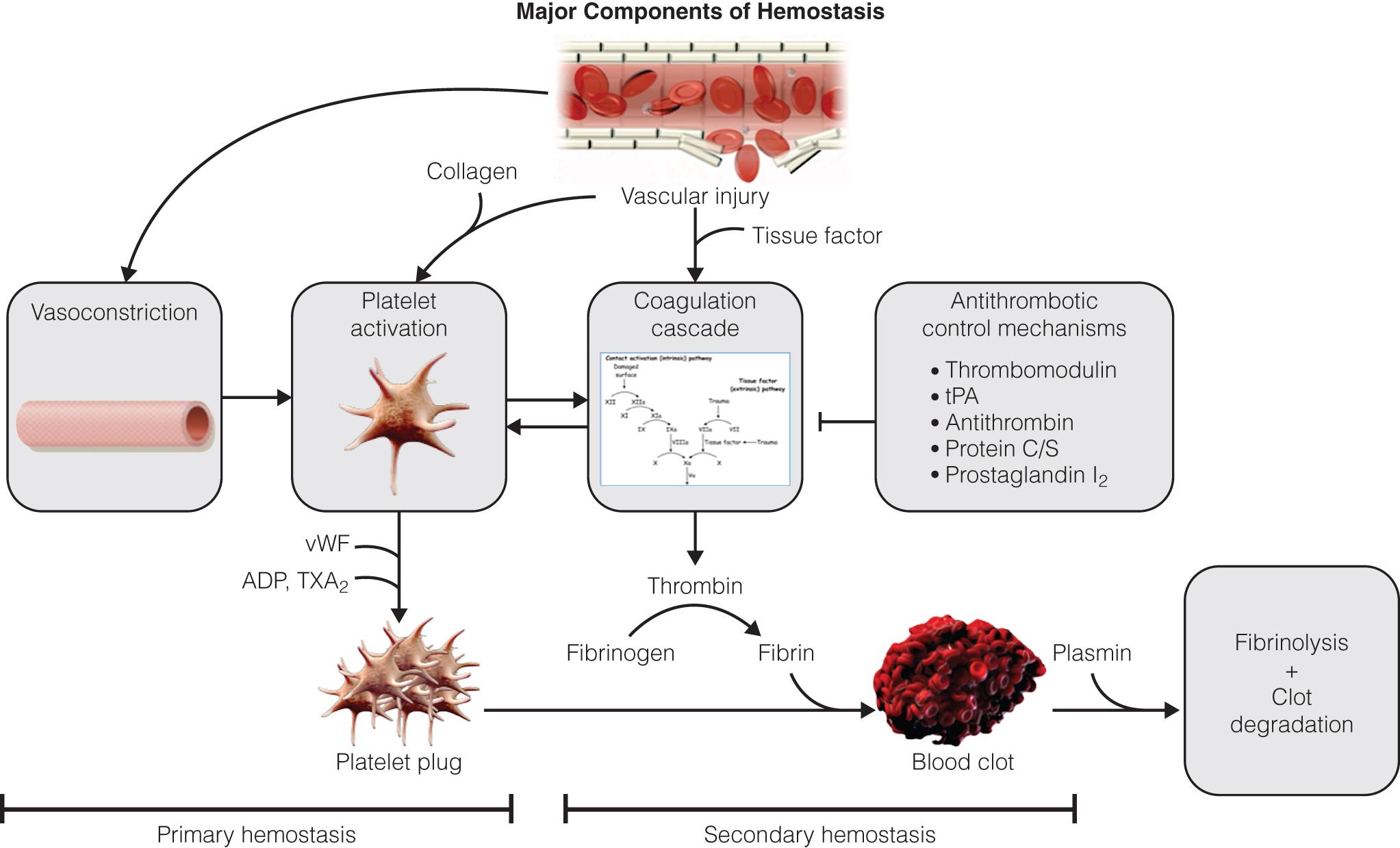Physical Address
304 North Cardinal St.
Dorchester Center, MA 02124
Fig. 129.1 depicts an overview of hemostasis. In a normal physiologic state, the body maintains a fine balance between hemorrhage and thrombosis through the regulation of various anticoagulant and prothrombotic systems. Four primary factors contribute to normal hemostasis. These factors are the vascular endothelium, platelets, coagulation factors, and fibrinolytic system.

The vascular endothelium is capable of evoking both antithrombotic and prothrombotic events. Under normal conditions, endothelial cells release prostacyclin and nitric oxide to inhibit platelet activation and promote vasodilation. After a tissue injury, vessel walls vasoconstrict to slow blood flow. Collagen and tissue factor (TF) are exposed and come in contact with blood. The exposed collagen initiates the accumulation and activation of platelets at the site of injury, while the TF triggers activation of coagulation factors. Once hemostasis has been obtained, the endothelium releases tissue plasminogen activator (tPA), activating fibrinolysis. ,
Platelets contribute their hemostatic capacity via adhesion, activation, and aggregation. Following the breach in the vessel wall, multiple signaling pathways are initiated that ultimately result in platelet activation. Once a platelet has been activated, additional platelets are recruited from the circulating blood to form a platelet plug via platelet–platelet cohesion. Thromboxane A 2 , an eicosanoid produced by activated platelets, functions in an autocrine or paracrine manner to stimulate for further platelet aggregation. The formation of the platelet plug is known as primary hemostasis.
After the nascent platelet plug is formed, it is stabilized by the formation of a fibrin mesh. The process by which this occurs is known as the coagulation cascade and is initiated by the exposure of tissue factor on the endothelial surface. The coagulation cascade consists of multiple factors that undergo a series of reactions that ultimately result in thrombin converting fibrinogen to fibrin. The fibrin meshwork stabilizes the platelet plug, forming a clot. This stabilization phase is also known as secondary hemostasis.
The fourth factor in normal hemostasis is the fibrinolytic system. Once the vasculature has been repaired, plasmin breaks down the fibrin strands, resulting in clot degradation. Of note, there are antithrombotic control mechanisms that prevent spontaneous intravascular coagulation and excessive clotting. These include thrombomodulin, tPA, antithrombin, proteins C and S, and prostaglandins.
The pathway by which hemostasis is obtained has traditionally been described by the extrinsic, intrinsic, and common pathways of the coagulation cascade. This classical model has been largely replaced with a “cell-based” model that incorporates the central role that cell surfaces play in coagulation. The cell-based model suggests that the process of coagulation occurs on different cell surfaces and occurs in three overlapping stages, which are initiation, amplification, and propagation. ,
The initiation phase of the cell-based model occurs on the surface of TF-bearing cells (including immunostimulated endothelial cells, fibroblasts, and monocytes). The TF interacts with and activates factor VII (FVII), forming the TF–FVIIa complex. This complex activates factor IX and factor X, which leads to the generation of a small amount of thrombin. This initial thrombin is essential for the activation of platelets and factors V and VIII.
The amplification and propagation phases occur on the surface of platelets. During amplification, the procoagulant signal is shifted from the TF-bearing cells to the activated platelets. This allows for diffusion of factor IXa, which activates the intrinsic pathway and subsequently leads to large-scale thrombin generation. In the propagation phase, factor VIIIa interacts with factor IXa forming the FVIIIa/FIXa complex, which is a powerful activator of factor X. Factor Xa forms a complex with factor Va, which catalyzes prothrombin to thrombin. This FXa/Va complex is 300,000-fold more active than factor Xa alone in catalyzing prothrombin activation.
Maintaining physiologic homeostasis between prothrombotic and excessive bleeding states requires a number of regulatory processes. Each component of the process of hemostasis can be disturbed, resulting in coagulopathy. Conditions that have been shown to cause coagulopathy include hypothermia, acidosis, and hypocalcemia.
Hypothermia may be a deliberately induced therapeutic maneuver or a consequence associated with trauma, surgery, or exposure. This can be exacerbated in patients who have sustained blood loss and are undergoing physiologic compensation with vasoconstriction. At a core temperature of less than 33°C, the coagulation cascade is impaired, platelet physiology is altered, and microvascular hypoperfusion is exacerbated. In turn, this worsens the degree of acidosis. Hypothermia decreases coagulation factor activity by 10% for each degree decrease in core temperature. , Platelet adhesion is reduced by 33% at 33°C compared with 37°C and further reduced by 47% at 23°C. In the nontrauma population, isolated hypothermia of 32.2°C leads to a 23% mortality rate, whereas in the trauma population, mortality approaches 100% when the core temperature reaches 32°C. ,
Acidosis has been shown to be one of the most important predictors in coagulopathy. The optimal pH for proteolytic activity of coagulation enzymes is well above physiologic pH. When the pH drops below 7.1, the ability of thrombin and fibrinogen to propagate a clot is severely diminished. The activity of FVII is reduced by 90%, which leads to more blood loss and furthers the cycle. Platelets lose their ability to change shape when a patient becomes acidotic, which in turn hinders their ability to form a clot.
Ionized calcium is a necessary cofactor in the coagulation cascade. Citrate anion is capable of binding (chelating) ionized calcium, and this is how the citrate component of acid citrate dextrose (ACD) buffer used in blood storage leads to anticoagulation. Patients who have received massive resuscitation with citrated blood products should receive appropriate calcium replacement. Additionally, it has been hypothesized that hypocalcemia is associated with poor clot strength in critically ill patients, particularly for ionized calcium levels of <1.0 mmol/L.
Become a Clinical Tree membership for Full access and enjoy Unlimited articles
If you are a member. Log in here